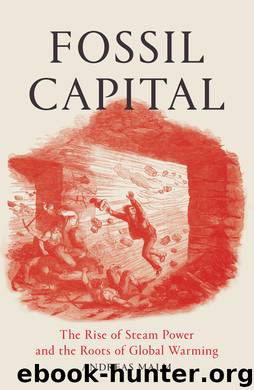Fossil Capital by Andreas Malm

Author:Andreas Malm
Language: eng
Format: epub
Publisher: Verso Books
CHAPTER 11
A Long Trail of Smoke:
The Fossil Economy
Consummated
By 1800, most of the smoke from British coal combustion still left fairly small chimneys. The best estimates put the share of household consumption at between half and two-thirds. A few rapidly developing industries already looked upon coal as a key input, but even the most important among them – iron – still accounted for no more than 10 to 15 percent of total demand; the dynamos of economic growth – cotton above all – used other sources.1 Combustion had yet to be decoupled from population, and so Britain could not be said to have constituted a fossil economy proper. By 1850, all of that had changed. The turning point occurred somewhere around the year 1830. One way of measuring it is to look at the average annual growth rates for coal production in Britain. The rate sped up somewhat between 1800 and 1815, only to – interestingly – slow down in the following fifteen years, the great acceleration taking place after the panic, with an apex in the years 1847–54. The span 1830–54 saw by far the highest rate of growth in coal production ever experienced between 1700 and 1900.2 British capital, both numbers and words tell us, wrested itself out of the crisis through an unprecedented mobilisation of energy from the stock.
More significantly for our definition of a fossil economy, domestic heating had lost its dominance by 1830. In 1816, it swallowed 53 percent of all coal produced in the nation; in 1830, the share stood below the critical mark at 45 percent, shrinking to 34 percent in 1840, 23.5 percent in 1855 and 14 percent in 1903. This secular reduction in the portion going to domestic heating – not the absolute volumes, of course – had begun already in the last two decades of the eighteenth century, but the sector accounted for more than half of all coal extracted in Britain up to some point between 1816 and 1830; by the latter date, it still constituted the single largest source of demand, a position it did not lose until after 1840. Between 1844 and 1855, another source ascended that throne: ‘general manufacturing’. In 1855, this sector took 28 percent of all coal produced, compared to 23.5 percent for domestic heating and 24.5 percent for iron and steel (if exported coal is excluded, the figures were 31 percent, 25 percent and 26 percent respectively). With manufacturers thus presiding over the largest share of combustion, followed by proprietors of iron- and steelworks, Britain had consummated the fossil economy. The structural crisis bequeathed a novel formation. By 1870, three times more coal was burnt in general manufacturing, iron and steel than in the hearths and homes of Britain, the fires decoupled from population growth and linked to self-sustaining economic growth.4
Download
This site does not store any files on its server. We only index and link to content provided by other sites. Please contact the content providers to delete copyright contents if any and email us, we'll remove relevant links or contents immediately.
The Secret History by Donna Tartt(18929)
The Social Justice Warrior Handbook by Lisa De Pasquale(12160)
Thirteen Reasons Why by Jay Asher(8831)
This Is How You Lose Her by Junot Diaz(6825)
Weapons of Math Destruction by Cathy O'Neil(6200)
Zero to One by Peter Thiel(5720)
Beartown by Fredrik Backman(5660)
The Myth of the Strong Leader by Archie Brown(5449)
The Fire Next Time by James Baldwin(5366)
How Democracies Die by Steven Levitsky & Daniel Ziblatt(5165)
Promise Me, Dad by Joe Biden(5108)
Stone's Rules by Roger Stone(5045)
A Higher Loyalty: Truth, Lies, and Leadership by James Comey(4899)
100 Deadly Skills by Clint Emerson(4872)
Rise and Kill First by Ronen Bergman(4732)
Secrecy World by Jake Bernstein(4693)
The David Icke Guide to the Global Conspiracy (and how to end it) by David Icke(4650)
The Farm by Tom Rob Smith(4460)
The Doomsday Machine by Daniel Ellsberg(4441)
